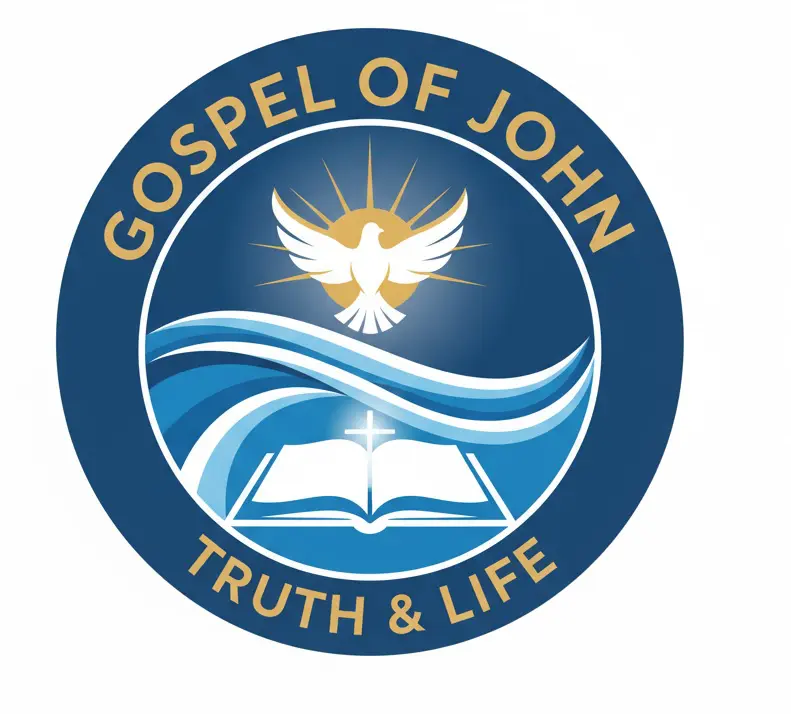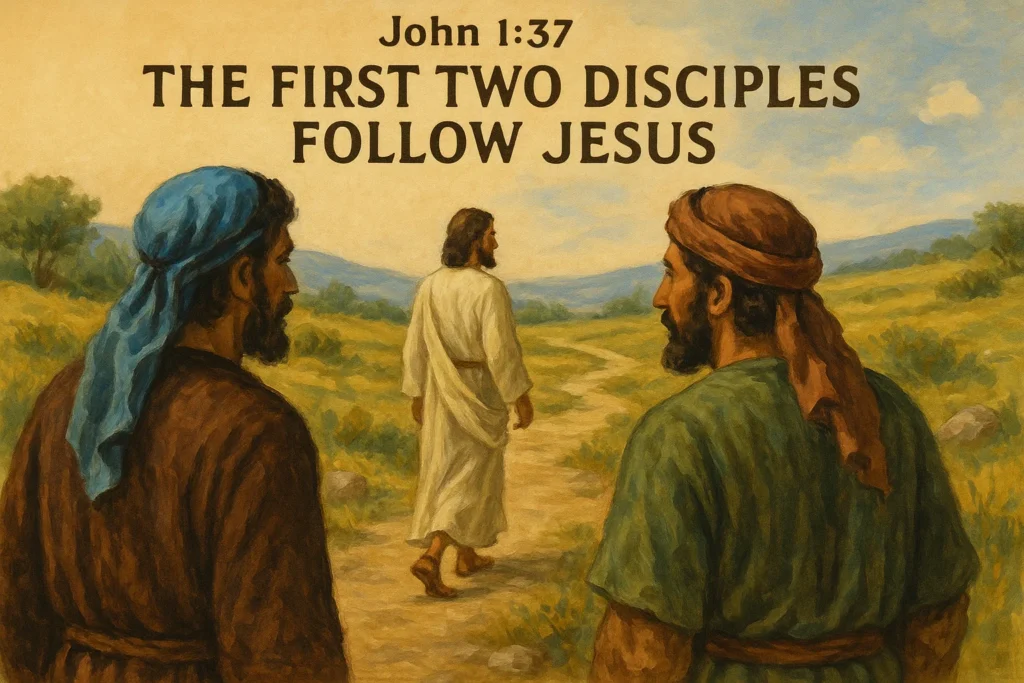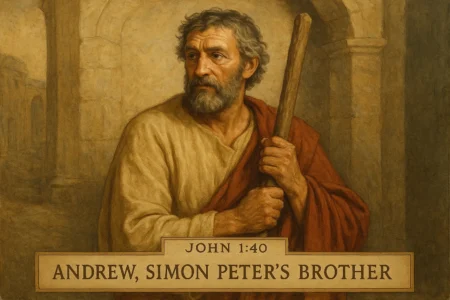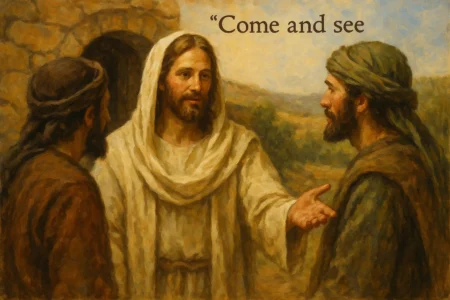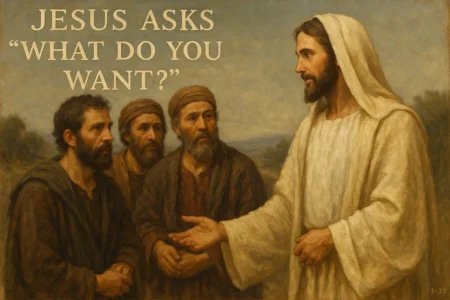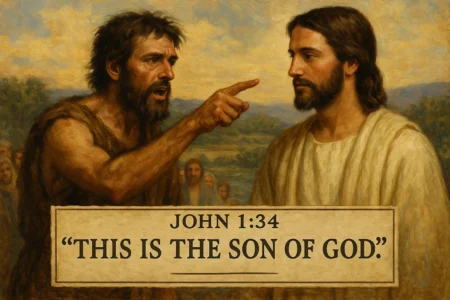Ever had a single sentence completely flip your life upside down? Someone drops a few words, and bam—your whole future pivots. It’s never some big, long speech, is it? It’s just a few words, spoken with this heavy clarity, that hit you so hard you just have to do something. I know I have. I still remember my college mentor. I’d just laid out this ‘perfect’ 10-year plan, and he just looks at me and says, “That’s a fine plan, but it’s not you.” Seven words. That was it. My career path changed for good.
That same kind of world-tilting pivot is exactly what we bump into in the Gospel of John, chapter 1. It’s a quiet scene. Deceptively simple. You could read right past it. No crowds. No miracles. No booming voice from the clouds. Just a teacher, two of his students, and another man walking by. The teacher points, says one short phrase.
And in a heartbeat, two of his followers turn and walk away from him to follow someone new. That’s the moment in John 1:37. This whole article, “John 1:37 Explained”, unpacks that single instant. It’s the story of the very first disciples, the tiny spark that lit the bonfire of the Christian faith. It’s a short verse. But it just might be one of the most important hinges in the whole book.
More in John Chapter 1 Category
Key Takeaways
- John 1:37 pinpoints the first-ever moment someone made the choice to follow Jesus: “The two disciples heard him speak, and they followed Jesus.”
- This didn’t happen in a vacuum. They followed because they heard John the Baptist’s testimony, who had just pointed Jesus out as “the Lamb of God.”
- We know one of the disciples was Andrew (Simon Peter’s brother). The other stays unnamed, but the overwhelming consensus is that it’s John, the guy who actually wrote this Gospel.
- This verse is the starting pistol for discipleship. It perfectly shows the one-two punch: hearing a testimony and then acting on it.
- Their quick move wasn’t a blind leap. It was an act of trust, faith built on the word of a witness they deeply respected.
- This one small event kicks off a huge chain reaction. Andrew’s first move is to find his brother, Peter, giving us the first picture of evangelism.
What Was the Vibe Right Before This Big Moment?
You can’t just read John 1:37 cold. You have to feel the static in the air. This moment wasn’t happening in a quiet little bubble. For months, a spiritual charge had been running through the entire region, and the source was John the Baptist. This guy was a total phenomenon. He wasn’t a polished city preacher. He was a rough-cut, locust-and-honey-eating prophet from the wilderness, and he spoke with a blunt authority no one had heard in generations. He was the “voice crying in the wilderness,” and his message was simple: “Repent, for the kingdom of heaven is at hand!”
And people flocked to him. Scribes, soldiers, Pharisees, everyday folks—they all trekked out to the Jordan River to be baptized, to confess their sins. He was, without a doubt, the biggest religious celebrity of his day. But John never let the fame go to his head. He was crystal clear about one thing: “I am not the one. I’m just the opening act. I’m not even worthy to untie the sandals of the man who is coming after me.”
His whole life, his entire ministry, was built to be a giant cosmic signpost. He was just the guy who points to the real guy.
So, that brings us to the day before our verse. John’s there with his disciples. He sees Jesus. He points. “Behold, the Lamb of God, who takes away the sin of the world!” (John 1:29). Fast-forward 24 hours. The next day—the day of our verse—he’s standing there again with two of his disciples. Jesus walks by again. John points again. “Behold, the Lamb of God!” (John 1:36).
What Did John Mean by “Behold the Lamb of God”?
Look, that wasn’t some casual nickname. That phrase was a theological grenade. For a first-century Jewish person, hearing “the Lamb of God” wasn’t just descriptive; it was a phrase packed with generations of meaning. Right away, it would have slammed two massive ideas into their minds.
First, the Passover lamb. That was the unblemished lamb whose blood on the doorposts in Egypt saved the Israelites from the angel of death. Its blood meant salvation. Deliverance.
Second, it would have made them think of the suffering servant in Isaiah 53. That’s the one who was “led like a lamb to the slaughter,” the one who carries our sin. This lamb wasn’t just for deliverance; it was for atonement.
So when John the Baptist levels his finger at Jesus and says, “There he is. The Lamb of God,” he’s making a claim that changes everything. He’s saying, “That man, right there, is the one. He is the ultimate sacrifice. He is the fulfillment of all our hopes. He is the one who will save us from our sins.”
It was that declaration ringing in the air. And that is what the two disciples heard.
So, What Does John 1:37 Actually Say?
And that brings us to the verse itself. It’s almost shockingly simple. After John drops this bombshell testimony, John 1:37 says:
“The two disciples heard him speak, and they followed Jesus.”
Just let that sink in for a second.
No one formed a committee. No one broke out a pro-con list. No asking for a second opinion. They heard. They followed. Period.
The Greek word used here for “followed” is akoloutheo. It’s a very physical word. It means to walk in the same way, to get in line behind someone. In that split second, they physically turned their backs on John—the man they had upended their lives to follow—and started walking after this new man, Jesus.
That’s the moment. That’s the first spark. Before this, Jesus had followers in a general sense, but this is the first recorded instance of discipleship, of someone leaving their current path to specifically follow him.
Why Is This Simple Sentence So Earth-Shattering?
This is really the core of what “John 1:37 Explained” is all about. You really can’t overstate how important this is. This quiet little sentence is the “big bang” of the entire Christian movement.
Just think. Every church, every believer, every denomination across two millennia… you can trace the whole lineage right back to this one tiny, dusty moment by the river. This is the transfer of allegiance. This is the official start of the ekklesia, the “called-out ones.”
It’s also the complete fulfillment of John the Baptist’s whole life. His job was to point. And in this moment, his own students proved he’d done his job. They looked where he pointed, and they went. This was the beginning of the end for John’s work and the absolute beginning of everything for Jesus.
Why Would They Just Drop Everything and Follow Him?
From where we sit in the 21st century, this can look… well, impulsive. Rash. Maybe even a little brainwashed. Why would two guys just ditch their teacher based on one sentence?
But this wasn’t a cold call. These weren’t just two random guys off the street. They were disciples of John the Baptist. That’s a crucial detail. It means they were already in a state of deep, active spiritual seeking. They had already repented. They were already living a life of discipline. They were actively, eagerly, and desperately waiting for the Messiah. Their hearts were primed and ready.
They hadn’t signed up with John just because he was charismatic. They were with him for one reason: he promised to show them the Messiah.
And then, he did.
So their action wasn’t a leap of blind faith. It was a leap of trust. They trusted their teacher. John had proven his integrity. He had proven his authority. And when that man, the most righteous man they knew, pointed at Jesus and said, “He’s the one,” they believed him.
How Much Did They Trust Their Teacher, John?
That trust is just… profound. John’s whole mission was to “decrease” so Jesus could “increase” (John 3:30). And here, he does it. He literally hands his own followers over. He makes himself obsolete.
It reminds me of that mentor I had at my first job. He spent a year pouring everything he knew into me. Then one day, he calls me into his office, pulls up a job opening at a rival company. A huge promotion for me. I was floored. “Why are you showing me this?” I asked. “It means I’d leave.” He just smiled. “My job isn’t to keep you. My job is to get you ready for what’s next. And you’re ready.”
That’s John the Baptist, to a T. He was a good mentor. He knew his job was not to gather followers for himself, but to prepare them for the one who was to come. His disciples’ trust in him was so complete that when he pointed them away from himself, they went.
Who Exactly Were These First Two Followers?
Okay, so who were these two guys who made this life-changing pivot? The text gives us one name outright and one heck of a compelling mystery.
In verse 40, after they’ve hung out with Jesus, the author clarifies: “One of the two who heard John speak and followed Jesus was Andrew, Simon Peter’s brother.”
Boom. There’s our first disciple: Andrew. This is huge, as we’ll see.
But what about the second guy? The text never names him. He’s just “the other disciple.” Why?
Why Is One Disciple Left Unnamed?
This little detail has kept scholars busy for ages. The most common and rock-solid tradition is that this unnamed disciple is John, the son of Zebedee, the man who wrote this very Gospel.
He does this all through the book. It’s his signature move. He never uses his own name, only referring to himself as “the disciple whom Jesus loved” or, in this case, just by a subtle implication.
This isn’t sloppy writing. It’s an incredible act of humility. John wants the spotlight to be 100% on Jesus, not on himself. He’s the narrator, the eyewitness, but he’s not the star. By staying in the shadows, he invites us, the reader, to step right into his shoes. He becomes the stand-in for all of us who hear the testimony and decide to follow.
Does It Matter Who the Second Disciple Was?
Oh, it matters. It matters immensely. If the author is this unnamed disciple, it means this entire book—one of the deepest, most profound books ever written—is not a piece of secondhand journalism.
It’s a memoir.
This isn’t John saying, “Hey, let me tell you a story I heard about how Andrew started following Jesus.” This is John leaning in and saying, “Let me tell you about the day my entire life changed. The day I first met him. I was standing right there…”
That changes everything, doesn’t it? It infuses the whole Gospel with the breathless, intimate energy of a personal story. He’s not just recounting history; he’s reliving the moment that defined him. As scholars at Biola University have pointed out, the early church was unified that John the Apostle was the author, precisely because of these kinds of intimate, “I was there” details.
What Did “Following Jesus” Even Mean to Them in That Moment?
So, picture this. Andrew and (we think) John physically turn and just start… walking behind Jesus. It must have been a little awkward, right? Just two guys tailing him down the road.
Jesus, of course, knows they’re there. He stops, turns around, and speaks his very first words in this Gospel. And his question just cuts right to the chase.
He asks: “What are you seeking?” (John 1:38).
He doesn’t ask “Who are you?” or “Why are you following me?” He asks a much, much deeper question: “What do you want? What is the deep-down desire in your heart that made you take this step?”
What Was Their First Conversation Like?
That question—”What are you seeking?”—is pretty much the fundamental question of human existence, isn’t it? And their answer is just as profound.
They don’t give a big spiritual speech. They don’t say, “We seek truth!” or “We want salvation!”
They say, “Rabbi, where are you staying?”
On the surface, it’s a weird, logistical question. But the subtext is beautiful. They’re not looking for a quick answer. They’re not looking for a 5-minute sermon. They’re basically saying, “We want to be where you are. We want to stop seeking and start staying. We want time with you. We want to see how you live.”
Why Did They Ask Where He Was Staying?
Their question just screams relationship, not just information. They instantly recognized that the Truth John was talking about wasn’t a set of rules or a philosophy. It was a person. And you can’t get to know a person in a quick Q&A on the side of a road.
You have to “abide” with them.
This word, “staying” (or “abiding,” from the Greek meno), becomes the central theme of John’s entire Gospel. Later, Jesus will say, “Abide in me, and I in you” (John 15:4). This first, simple question from the new disciples sets the stage for that entire theology. They’re not looking for a new philosophy. They’re looking for a new home.
How Does This Scene Challenge Our Idea of “Blind Faith”?
This little scene is the perfect antidote to that modern idea that faith is just a “blind leap in the dark.”
It wasn’t blind at all. It was faith based on testimony. They had a credible word from the most trusted prophet in Israel. It wasn’t a leap in the dark; it was a step into the very light their teacher had just pointed out.
It makes me think about my own decision to change careers years ago. To my colleagues, it looked like I just woke up one morning and threw away a stable, high-paying job for some crazy new venture. It looked like a total blind leap. What they didn’t see were the six months of late-night conversations. They didn’t see the books I’d read, the spreadsheets I’d run, the long, hard talks with my wife. They didn’t see the “testimony” I’d been gathering. My decision wasn’t blind. It was the logical, terrifying, but necessary conclusion of a long investigation.
In the same way, Andrew and John’s decision was the logical, faithful, and sane response to the testimony they’d just heard.
So, Faith Is Based on Hearing?
Exactly. This is a bedrock principle in the Bible. The Apostle Paul would hammer this home later: “So faith comes from hearing, and hearing through the word of Christ” (Romans 10:17).
Andrew and John are the poster children for this.
- They heard the word (John’s testimony).
- They believed the word.
- They acted on the word.
This is the pattern. We are all presented with testimony—through the Bible, through a pastor, through a friend, through creation itself. The question is not, “Can you believe this with no evidence?” The question is, “What will you do with the testimony you have been given?”
Let’s Talk About Andrew. What Does He Do Next?
This, right here, is where the chain reaction ignites. They spend the afternoon with Jesus. The text says they “stayed with him that day.” And that one afternoon is all it takes to convince Andrew of everything.
So what’s the absolute first thing he does?
“He first found his own brother Simon…” (John 1:41).
He doesn’t go pray about it. He doesn’t go to the synagogue to discuss it. He runs. He sprints to find the person closest to him in the world, his brother Simon.
“We Have Found the Messiah.” Can You Imagine That Conversation?
You can just feel the energy vibrating off the page, can’t you? He grabs his brother by the shoulders, his eyes wide, and makes the proclamation:
“We have found the Messiah!”
This isn’t a casual, “Hey Simon, met this cool new teacher, you should check him out sometime.” This is the fulfillment of a 2,000-year-old promise. This is the climax of all of Jewish history. “Messiah” means “the Anointed One,” the long-promised King who would come and save Israel.
And notice: Andrew doesn’t just invite Simon. He brings him. The text is clear: “He brought him to Jesus.”
Just stop and think about that. Because of John 1:37—because Andrew heard and followed—he was able to introduce his brother to Jesus. And that brother, Simon, is the one who would be renamed Peter. The “rock.” One of the most significant figures in all of human history was brought to Jesus by a guy who had only been a follower for about 24 hours.
What Does Andrew’s Action Teach Us About Discipleship?
Andrew’s model is as simple as it is powerful: When you find something truly good, you can’t keep it to yourself.
Look, Andrew is never the star of the show. He’s not the one who preaches to thousands at Pentecost. He’s not the one who writes a Gospel. But here’s the deal: without Andrew, there’s no Peter. He becomes “The Introducer.” He’s the guy in the background who’s always bringing people to Jesus. Later in John’s Gospel, he’s the one who brings the boy with the loaves and fishes to Jesus (John 6). He’s the one who brings the Greeks who want to see Jesus (John 12).
His entire legacy is right here, born in this one simple impulse: “I found him. I have to go get my brother.”
- Andrew’s Legacy:
- He listened with his whole heart.
- He acted without hesitation.
- He shared his discovery with passion.
- He physically brought others to Jesus.
What About the Other Disciple, John? What’s His Story?
So if Andrew’s immediate response was to go out, John’s response was to go deep.
If this is, in fact, John the Apostle, then this moment in John 1:37 is the day he got his life’s mission. He “heard and followed,” and then he spent the rest of his life, culminating in this very Gospel, unpacking the “why.”
He became “the disciple whom Jesus loved,” the one who leaned against Jesus at the Last Supper, the one who stood at the foot of the cross. He was the one who “saw and believed.”
How Did This First Encounter Shape John’s Writing?
John’s entire Gospel is colored by this very first encounter. It explains his obsession with the word “abide”—or “stay” or “remain.” It all started with that first simple question, “Where are you staying?” and that first simple invitation, “Come and see.”
He never, ever forgot the intimacy of that first afternoon. It defined his understanding of who Jesus was. For John, Jesus wasn’t just a great teacher or a miracle worker. He was “the Word made flesh” (John 1:14). He was the one you could stay with.
That afternoon, he and Andrew didn’t just download some information. They had an experience.
What Does Jesus’s Invitation “Come and See” Really Mean?
When they ask, “Where are you staying?” Jesus doesn’t give them an address.
He gives them an invitation. “Come and see” (John 1:39).
In three words, that’s the call of Christianity. It’s not, “Come and agree to this list of doctrines.” It’s not, “Come and follow these rules.” It is, “Come and see for yourself. Come and experience me. Come and stay with me.”
Jesus just offers himself. He invites them into his life. He is not afraid of their scrutiny. He welcomes it. “Come and see.”
How Long Did They Stay?
And John, the eyewitness, gives us this wonderfully specific, human detail: “So they came and saw where he was staying, and they stayed with him that day, for it was about the tenth hour.” (John 1:39).
By Roman time, the “tenth hour” was about 4:00 PM.
This means they didn’t just get a 10-minute handshake. They spent the entire evening with him. They had dinner. They talked long into the night. It was in that context—the intimacy of a shared meal and a long, unhurried conversation—that they became utterly convinced. By the next morning, Andrew was certain: “We have found the Messiah.”
It reminds me so much of my own faith journey. When I first started kicking the tires on Christianity, I was like a lot of men I know. I was waiting for the lightning bolt. I wanted that dramatic, road-to-Damascus moment.
It never came.
For me, it was way more like John 1:37. I “heard” some testimony from books and a few friends I trusted. I decided to “follow,” mostly out of curiosity. And my conversion was just the slow, steady, daily process of “staying with him.” It was committing to reading a little every day. It was praying, really awkwardly at first, in my car on the way to work. It was just “coming and seeing,” over and over. The big change didn’t happen in a flash. It happened in the “staying.” The man I am today was forged in that quiet, daily, showing up, not in a single, spectacular event.
Is John 1:37 Just History, or Is It an Invitation?
And that really brings us to the whole point, doesn’t it? This “John 1:37 Explained” article isn’t just a history lesson. It’s a mirror.
This verse is a living, breathing invitation. We are the ones, right now, who “hear” the testimony. We hear it in the words of this Gospel. We hear it from the lives of believers around us. We hear it from the “John the Baptists” in our own lives who point us toward Christ.
The testimony has been given. And the question for us is the exact same one that hung in the air on that dusty riverbank: Now that we’ve heard, what are we going to do?
How Do We “Follow” Jesus in the 21st Century?
Following Jesus today looks remarkably similar to how it did then. It’s not about physically walking down a road, but it is a complete reorientation.
It means that when we hear his words, we actually act on them. It means we stop walking in whatever direction we were heading and we align our path with his. Our priorities, our ambitions, our bank accounts, our calendars… they all start to shift.
Following isn’t a one-time ‘yes.’ It’s a daily direction.
- Modern Following
- Prioritize His Word: We “hear” him by making the Gospels a non-negotiable part of our lives.
- Seek His Presence: We “stay with him” through the simple disciplines of prayer and community.
- Reorient Your Path: Following means your life-direction actually changes. The ‘old self’ has to give way to the ‘new self.’
- Share Your Story: Just like Andrew, the most genuine, natural result of “staying with him” is the powerful urge to go tell someone else, “I have found him.”
Is It Really That Simple? Just Hear and Follow?
So, is it really that simple? Just ‘hear and follow’?
Yes. And no.
The decision itself, in that moment, is beautifully simple. They heard. They followed. It’s the beginning.
But that one simple decision has massive, lifelong, world-changing implications. Following Jesus cost Andrew and John everything. Tradition tells us both men died as martyrs. Following him led them into poverty, persecution, shipwrecks, and prisons.
This verse isn’t the end of the story. It’s the first page of the greatest adventure ever lived. It’s the “yes” to the call. The journey that follows will demand everything of them. And in return, it will give them everything that matters: a new purpose, a new identity, and a new “home” with the God of the universe.
What If I’m Not Sure I’ve Heard?
Maybe you’re reading this right now and thinking, “I’ve never had that ‘Lamb of God’ moment. I’m not sure.”
If that’s you, my advice is to simply take the posture of the disciples. Be curious. Be a seeker. Don’t wait around for a lightning bolt. Just ask the question they asked: “Rabbi, where are you staying?”
In other words, go to the source. Don’t rely on my opinion or anyone else’s. Read the Gospels for yourself. Read the Gospel of John. “Come and see.” Give him the “afternoon” of your attention. See what happens when you just decide to “stay with him” for a season. Put yourself in the path of the testimony.
Because the story of John 1:37 isn’t just about two men from 2,000 years ago. It’s the story of how it all begins. Again and again.
“The two disciples heard him speak, and they followed Jesus.”
It might be the most human, and the most divine, sentence ever written. It’s the whole story in miniature: a God who makes himself known, and two ordinary men who were brave enough to take one small step. The rest, as they say, is history. Their history. And ours.
FAQ – John 1:37 Explained
What is the significance of John 1:37 in the Christian faith?
John 1:37 marks the first recorded moment when individuals chose to follow Jesus, symbolizing the beginning of discipleship and the Christian movement. It highlights the pivotal act of hearing testimony and acting on it, which is foundational to faith.
Why did the disciples immediately decide to follow Jesus after hearing John the Baptist’s testimony?
The disciples trusted John the Baptist’s credibility and were spiritually primed for the Messiah. Hearing his testimony that Jesus was the Lamb of God inspired their trust and prompted them to follow Jesus, seeing it as a logical, faith-based step.
What does the phrase ‘Follow me’ mean in today’s context compared to back then?
In today’s context, ‘following’ Jesus involves a daily reorientation of priorities, aligning one’s life with his teachings through actions like reading the Bible, prayer, and service, rather than a physical act of walking behind him.
What can we learn from Andrew’s immediate action after meeting Jesus?
Andrew’s example teaches us that when we encounter something truly valuable, we should share it passionately and urgently, exemplified by his immediate effort to bring his brother Simon to Jesus.
How does John’s relationship with Jesus influence his approach to writing the Gospel of John?
John’s personal experience of intimacy with Jesus profoundly shapes his Gospel, emphasizing themes of abiding, staying close to Christ, and experiencing Jesus personally, which reflect his own first-hand encounter and deep relationship with Jesus.
